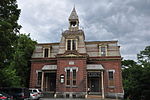Woodsville, New Hampshire
Census-designated places in Grafton County, New HampshireCensus-designated places in New HampshireHaverhill, New HampshireNew Hampshire populated places on the Connecticut RiverRailway towns in New Hampshire ... and 2 more
Use mdy dates from July 2023Woodsville, New Hampshire

Woodsville is a census-designated place (CDP) and the largest village in the town of Haverhill in Grafton County, New Hampshire, United States, along the Connecticut River at the mouth of the Ammonoosuc River. The population was 1,431 at the 2020 census. Although North Haverhill is now the county seat of Grafton County, the village of Woodsville has traditionally been considered the county seat, as the county courthouse was originally located there. The county buildings are now located halfway between Woodsville and the village of North Haverhill to the south.
Excerpt from the Wikipedia article Woodsville, New Hampshire (License: CC BY-SA 3.0, Authors, Images).Woodsville, New Hampshire
Central Street,
Geographical coordinates (GPS) Address Nearby Places Show on map
Geographical coordinates (GPS)
| Latitude | Longitude |
|---|---|
| N 44.152222222222 ° | E -72.036944444444 ° |
Address
Central Street 76
03785
New Hampshire, United States
Open on Google Maps







